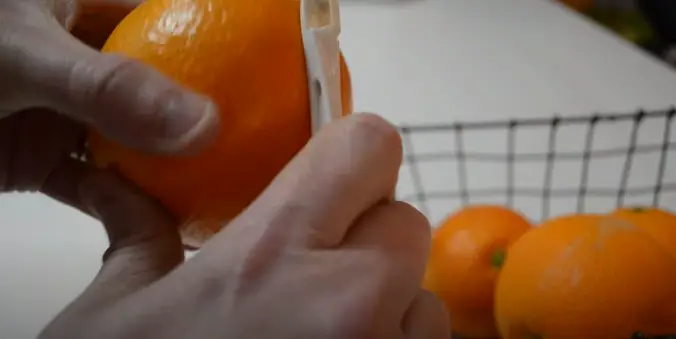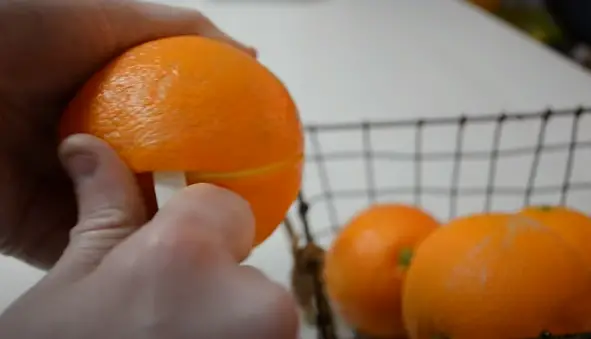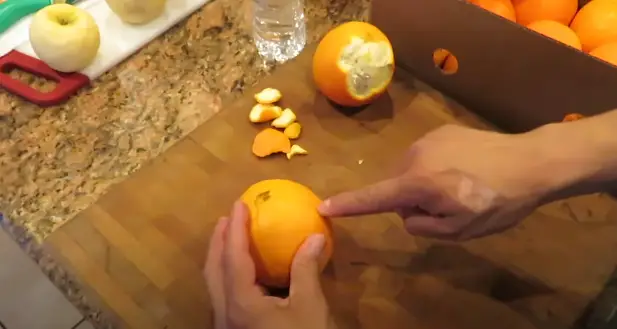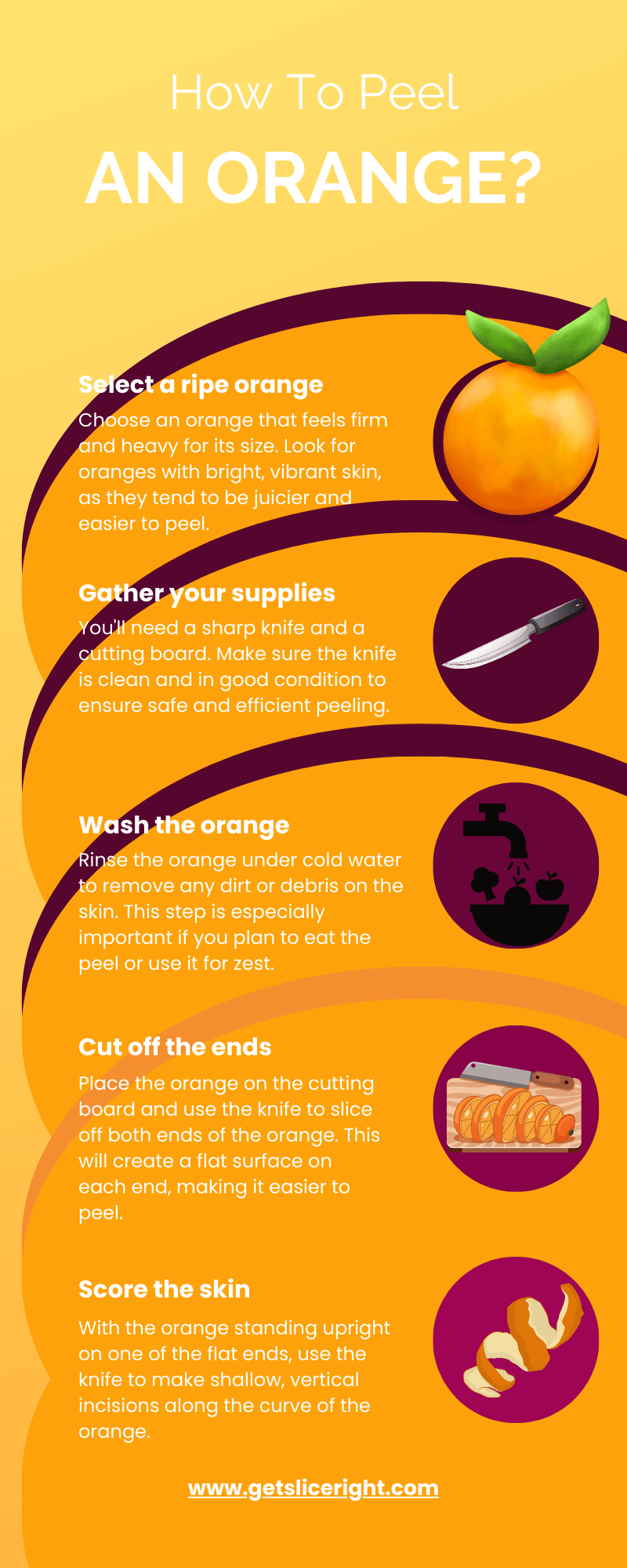Peeling an orange is a simple yet important skill that allows you to enjoy this nutritious fruit conveniently. It involves techniques to remove the skin while leaving as much of the juicy fruit intact as possible. There are several ways to peel an orange, some involving just your hands, others requiring a knife, and the chosen method often depends on how you plan to consume or use the orange afterward. This seemingly simple task can be mastered easily with some practice, making incorporating oranges into your diet easier, whether as a quick snack or an ingredient in various dishes.
What Is An Orange Peeler?

An orange peeler is a tool used to remove the rind or skin from an orange. It consists of a handle with two curved blades that come together at one point and can be pulled apart to cut through the peel. The blades are usually made of stainless steel and can provide a clean, even cut to ensure all the pith (white part of the peel) is removed. This makes removing the peel easier and enjoying the sweet, juicy fruit inside. Orange peelers are a must-have for any home kitchen and can be found in most grocery stores or online retailers.
How To Peel An Orange With Peeler?
Step 1: Wash the orange with warm water and soap to remove dirt or residue.

Step 2: Use a sharp vegetable peeler to cut away the orange’s skin carefully. Make sure to keep your fingers away from the blade.

Step 3: Once you have removed all the skin, use your hands to remove any remaining pieces of pith or oils from the orange.
Step 4: Slice the orange into sections, and enjoy!
How To Peel An Orange With Hands?
Step 1. Rinse the orange well under cold water to remove any dirt or debris.
Step 2. Take a sharp knife and cut off the top and bottom of the orange so that it has flat surfaces which you can hold easily in your hand.

Step 3. Start from one end, and slide the blade of your knife between the orange flesh and the inner white membrane.
Step 4. Continue to cut along the circumference of the orange, slicing off thin strips of peel as you go. Make sure to leave as much of the pulp intact as possible.

Step 5. Once all of the skin has been removed, carefully remove any remaining pieces of the white pith from the orange flesh.
Step 6. Cut the orange in half and then into wedges for easier consumption.
Knife And Spoon Method For Peeling Oranges
Step 1. Gently wash the orange to remove any dirt or debris.
Step 2. Cut off the top and bottom of the orange with a sharp knife until you reach the middle of the fruit.
Step 3. Hold one end in your dominant hand and use a spoon to gently pry off pieces of peel from the sides of the orange.
Step 4. Use your spoon to scrape any remaining peel along the edges and between the segments.
Step 5. Once all the peel is removed, you can cut the orange into slices or eat it as-is.
With these simple steps, you’ll have a peeled orange quickly.
How To Peel Orange Without The White Stuff?
Step 1: Slice off the top of the orange, just below the stem and just above the curve at the top.
Step 2: Starting from the top, make a deep cut into one side of the fruit while counting down to halfway around it in a circular motion. Cut all around the circumference until you get to your starting point.
Step 3: Open the fruit like a book and remove the peel. Hold the top of the orange with your other hand so it doesn’t roll away from you.
Step 4: Peel off each section of the skin by placing one hand on top of the orange, fingernails facing down, and use your other hand to pull away each section of skin, starting at the top and going downward.
Step 5: Cut off any remaining white pith that sticks to the orange segments. This be done with a sharp knife or kitchen shears.
What Can You Do With Orange Peels?
- Make an Orange Peel Cleaning Solution: Orange peels contain a natural cleaner called d-limonene that can be used as an all-purpose cleaner for surfaces and fabrics. To make the cleaning solution, fill a 1/2 gallon of hot water with one cup of chopped orange peels and let it steep overnight. Strain the liquid and pour it into a spray bottle.
- Make an Orange Peel Air Freshener: Orange peels can be natural air fresheners! Just add slightly dried orange peels to a bowl of white vinegar and let it sit overnight, then empty the bowl in the morning and enjoy your fresh-smelling home.
- Use as a Natural Insect Repellent: Orange peels can repel certain insects such as ants, mosquitoes, and fruit flies. To make an orange peel insect repellent, steep dried orange peels in boiling water for about 10 minutes and then strain the liquid into a spray bottle. Spray it on surfaces or in areas where insects are present.
- Add to Compost: Orange peels can be added to your compost pile or bin and help break down other organic materials. This helps to improve the nutrient content of the soil, making it a great addition to any garden!
- Use as a Natural Scrub: Orange peels can be used as a natural scrub for tough messes. Simply add some of the dried peel in a little olive or coconut oil and use it to scrub away tough stains like crayon marks or paint splatters.
- Use as Potpourri: Dried orange peels can be added to other herbs and spices to make a natural potpourri. Simply mix together the ingredients in an air-tight container and let it sit for a few days before using. It’s a great way to add a nice scent to your living space!
- Natural Fertilizer: Orange peels can be used as a plant fertilizer. To make the fertilizer, steep dried orange peels in water for about 24 hours, strain the liquid, and mix it with equal water. Use this to fertilize your plants.
What Makes An Orange Easy To Peel?
- Choose oranges that are slightly soft to the touch, with smooth skins; these will be juicier and easier to peel. Avoid hard oranges or those with blemishes or bruises, as they won’t be as easy to peel.
- When you have found the right orange, wash it off and pat dry with a paper towel. Make sure your hands are clean as well.
- Slice off the top and bottom of the orange with a sharp knife, then cut away the skin in sections. Work from top to bottom, following the natural curves of the fruit.
- Once you have peeled all the skin from an orange, divide it into sections by cutting between each segment.
How To Peel Orange Without Getting Sticky?
Step 1. Start by washing the orange with hot water and a mild soap or fruit wash. This will help remove any dirt, wax, or other contaminants on the surface of the orange.
Step 2. Cut off both ends of the orange to expose sections of flesh between each segment.
Step 3. Using a paring knife, make an incision around the circumference of the orange and slip your finger into the gap you’ve created.
Step 4. Gently pull back on the skin until it separates from the flesh. You should be able to peel away sections of skin in one go rather than having to do each segment individually.
Step 5. Once the orange is peeled, you can easily separate each segment from one another and enjoy your juicy snack.
FAQs
Do you slice oranges or peel them whole?
If you’re using the orange for a snack or in a salad, it is best to slice the orange. If you add the oranges to another recipe, peel them whole and dice them as desired.
What are the different types of oranges?
There are many types of oranges available in the market. The most common varieties include Valencia, Navel, Blood, Cara Cara, and Mandarin oranges. Each type has a unique flavor and texture. Valencias are sweet and juicy with a bright orange color; Navels have a slightly tart taste and contain large, easy-to-peel segments; Blood oranges have deep red flesh that is sweet and slightly tart; Cara Caras are similar to Navels but with a deep pink flesh and sweeter flavor; and Mandarins are small in size and have a sweet, mild flavor.
What is the sweetest orange?
The sweetest type of oranges are generally navel oranges because of their high sugar content. Navel oranges have a thick skin that can be difficult to peel but yield juicy, flavorful segments when peeled correctly.
What are the nutritional benefits of oranges?
Oranges are a great source of Vitamin C and a good source of dietary fiber, potassium, and folate. They contain flavonoids that can help reduce inflammation in the body and antioxidants that can help protect cells from damage caused by free radicals. Additionally, oranges are beneficial for reducing cholesterol and helping to lower blood pressure. Eating oranges can also help boost your immune system, improve digestion, and even help you lose weight. So not only are they delicious, but they’re good for you too!
Which region is famous for oranges in the world?
Oranges are a popular fruit consumed worldwide but are most commonly associated with the sunny Mediterranean climate of countries such as Spain and Italy. In fact, both these countries produce a significant portion of the oranges that make up Europe’s total orange production. Other major producers in the United States include China, Brazil, Mexico, Turkey, Egypt, and California. The Mediterranean region is also widely considered one of the best regions to grow oranges, thanks to its favorable climate and soil conditions.
Conclusion

Peeling an orange effectively is all about finding the best method for you. Whether using your hands or a knife, the goal is to remove the peel and pith without damaging the fruit. With some practice, you’ll find that it’s a simple, quick process that lets you enjoy this nutritious fruit in all its forms. Whether you’re eating an orange as a snack, adding it to a salad, or using it in a recipe, proper peeling will enhance your culinary experience.

Mario Batali is a renowned author, food enthusiast, and passionate chef who has dedicated his life to exploring the world of culinary arts. With a love for sharing his knowledge and experiences, Mario has become a prominent figure in the food blogging community, inspiring countless readers with his creativity and expertise.
In addition to his culinary prowess, Mario Batali is also a talented writer with a flair for engaging storytelling. He launched his own food blog to share his recipes, cooking tips, and personal experiences in the kitchen. Over time, Mario’s blog gained a loyal following of food enthusiasts who appreciate his unique approach to cooking and his dedication to using only the finest ingredients.
Mario Batali’s passion for food and his commitment to sharing his knowledge with others have made him a true inspiration in the world of culinary arts. Through his blog, cookbooks, and public appearances, Mario continues to spread his love of food and the joy of cooking with his ever-growing fanbase.







